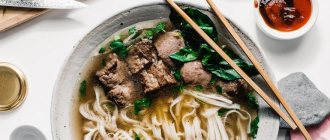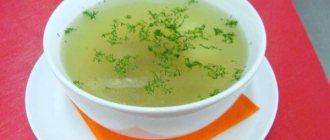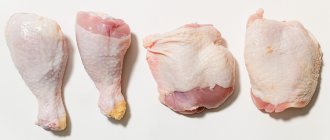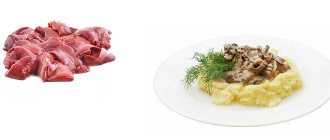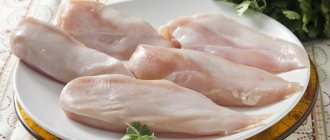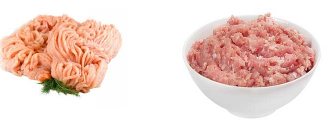How many calories are in different servings:
184
233
2.33
| Qty | A portion | Calories | In the counter |
| 1 PC. (from 500 g cooked chicken) = 79 g | 184 | ||
| 100 g | 233 | ||
| 1 g | 2.33 | ||
| 326 | 1 cup diced = 140g | 326 | |
| 66 | 1 ounce = 28.3g | 66 |
Calorie content of related products:
Chicken Breast (184cal) Steamed Chicken (175cal) Cooked Chicken (237cal) Chicken Fillet (150cal) Boiled Chicken (215cal) Chicken Wings (241cal) White Meat Chicken (188cal) Chicken Fillet (150cal) Skinless Chicken (150cal) Chicken Cutlet (290cal) Chicken Steak (239cal) Grilled Chicken (193cal) Chicken Meat (181cal) Fried Chicken (284cal) Rotisserie Chicken (150cal) Chicken Thigh (226cal) .) Whole Fried Chicken (227cal) Baked Chicken (150cal) Lean Chicken (143cal) Skin-On Chicken (234cal) Sauteed Chicken (217cal) Chicken Skin (423cal) Canned Chicken (155cal) Chicken Gizzard ( 154cal.) Ground Chicken (189cal.) Chicken Heart (185cal.) Chicken Liver (170cal.) Stewed Chicken (210cal.) Raw Chicken (172cal.) Chicken Giblets (191cal.) Chicken Leg (188cal.) Whole Chicken (239cal.) )
Application
As mentioned earlier, chicken legs can be used very multifunctionally in any preparation: frying, boiling, stewing. The most common recipes can be found for baked chicken legs in the oven with cheese and potatoes, but they are not very healthy for a healthy diet. Any first course will go perfectly with this type of meat - both a simple soup with noodles and a simple soup with vegetables. You can cook chicken legs baked in garlic sauce, you can stew them in pots with mushrooms and potatoes - any first and second courses, salads, appetizers will go perfectly with this type of meat.
Market Analytics
- Global cosmetics market 2021: an unprecedented test for the global cosmetics industry
- Top 10 Cosmetic Research and Development of 2021
- 2020 in the beauty industry – innovation without borders
Convenient search for beauty salons on our website
Beauty salons in Moscow Beauty salons in St. Petersburg Beauty salons in Ekaterinburg Beauty salons in Novosibirsk
Latest blog posts on our website
- Naturecream / Properties of the “Sunny” oil itself
- Naturecream / “Sugar” wrinkles - or what glycation can do
- Naturecream / Esterified oils
- Naturecream / Arnica - the magical plant of alchemists
- Naturecream / Tremella Extract - Snow Mushroom Detox for Skin
- Prostye-sovety / How to visually enlarge your lips with makeup
- Naturecream / Apricot kernel oil for face
- Naturecream / MATRIXYL3000 - the best skin elasticity stimulator
- Naturecream / SPF in Natural Oils
- Naturecream / Geranium (Pelargonium) oil for skin health and beauty
Latest forum topics on our website
- Natalya / How to properly make a gelatin mask?
- Mrs._Smith / Badly sunburned! What to do?((
- Ice / Is it necessary to combine fitness classes with a diet?
- Antonova / What can be used for hair loss?
- Radio operatorKat / Who was on a protein diet?
Other articles in this section
| Turkey (leg) Turkey is deservedly considered one of the best types of meat, because it contains everything essential for the human body, taking into account the fact that turkey meat is easily digested and assimilated. This type of meat is recommended to be introduced into complementary foods for babies first, as it is safe and cannot cause allergies. In terms of the content of vitamins and microelements, turkey meat is superior to chicken, beef and pork, and in terms of phosphorus content it is almost equal to fish. |
| Beef neck Beef neck or neck is the most popular type of meat; it is the part of the carcass close to the head. It runs along the entire spine and therefore does not contain bones. The neck is permeated with greasy veins, which allows it to maintain juiciness and moisture after long baking in the oven. The younger the animal, the more tender the meat will be, but the softest and juiciest meat is veal. With age, muscles and ligaments become coarser, and then the meat becomes tough. The freshness of the neck is checked by pressing on a piece of meat - if it springs back, then the meat is fresh. As a rule, fresh meat has a bright red color and a pleasant smell. |
| Pork shoulder Pork shoulder is famous for its tender texture, where the ratio of meat and fat is ideal. It is one of the best parts of the mascara. Pork shoulder dishes are always tender, aromatic, surprisingly juicy and healthy. And with all this, pig meat is easily absorbed by the body. Interestingly, pork is considered a natural antidepressant due to the special substances it contains, that is, an excellent mood is guaranteed when eating pork. A high-quality piece of shoulder should be light red in color, without a hint of greenery and with white veins, and there should also be no foreign odors, only the smell of meat. |
| Boiled turkey Boiled turkey is a very tasty and healthy dish that has virtually no contraindications. Turkey is the second most popular bird after chicken. It used to be called the Indian chicken because of its appearance and colorful feathers. This chicken was believed to be of American origin. In its homeland, it is very popular - not a single holiday is complete without it. In terms of quality and taste, it is in no way inferior to chicken and other meat. |
| Fried chicken liver Fried chicken liver is one of the common delicacies and one of the most expensive parts of chicken. At the same time, many popular dishes are made from it in various countries. Cuisines of all nations of the world use this offal in their recipes. Fried chicken liver is devoid of astringency and bitterness, unlike the liver of other animals, such as pork. In some countries, fried chicken liver is a remedy for overwork and stress. In Korea, it is very popular among doctors. Nutritionists emphasize the importance of including chicken liver in the diet, but one should take into account the fact that the liver of any animal always processes radioactive and harmful substances, so it is recommended to consume it no more than once a week. |
| Pork Jowl Pork jowl is the meat from the front of an animal carcass, which can be a single piece or two pieces. If the cut is made by a professional butcher using a special technology, then it will be whole, but when the head of an animal is simply chopped off, one part of the cheek remains on the head, and the second on the carcass. This product consists of alternating layers of meat and fat. Properly cooked cheek is soft, tender and juicy. |
| Quail A very small bird, whose weight does not even reach half a kilogram, is the quail. Its meat contains a very large amount of vitamins and mineral compounds useful to our body, even despite the fact that this meat is dietary. The quail in its appearance resembles a short-legged small chicken, and it is also a fairly terrestrial bird, which resorts to flight only in the most rare cases. The common quail lives mainly in fields and is found on the territory of the Eurasian continent, as well as in Africa. Previously, these small birds were one of the favorite trophies of hunters, but nowadays quails can already be found on the shelves of almost all stores. They began to be grown on poultry farms and simply in households, both to obtain tasty and healthy dietary meat, and to produce eggs, which also contain many different vitamins and microelements. |
| Camel meat Camel meat is a rather exotic product for the Russian region, but quite common for the countries of Asia and the Middle East. Since ancient historical times, trade caravans have been known that transported goods from one end of the world to the other. Traders traveling with caravans and transporting their goods knew in advance about the long and difficult journey that lay ahead of them. Very few products could survive that long without spoiling. But well-cooked camel meat can be on the road any time without losing its taste. Therefore, on the road you could always count on a good exchange for any other products. In Mongolia, fat, which was quite valuable, was rendered from meat. Thanks to caravans, this product became widespread throughout the world. |
| Bone-in Pork Belly Pork belly is the portion of meat on the rib bones of a pig. It is considered dietary meat, since its calorie content is very low. Belongs to the highest grade of meat of this animal. |
| Bear meat Thousands of years ago, people first began to hunt bears. For a long time, the meat of these animals often saved people from hunger, and the skins helped to keep warm in winter. Today, bear meat is consumed very rarely, and the meat itself is considered a delicacy. However, even in our time, forest game lovers buy it from hunters to cook it themselves, or they can order a bear meat dish in an expensive restaurant. |
Composition of nutrients, BJU
Chicken leg - 1 pc. (from 500 g cooked chicken) (79 g)
| For quantity: 1 piece. (from 500 g cooked chicken) | ||
| Calories — 184 | Calories from fat - 93 | |
| BJU | ||
| Total fat content | 10.37g | |
| Saturated | 2.8g | |
| Polyunsaturated | 2.35g | |
| Monounsaturated | 4.12g | |
| Cholesterol | 78.21 mg | |
| Total carbohydrate content | 2.21g | |
| Dietary fiber | 0.08g | |
| Sugar | 0g | |
| Squirrels | 19.12 | |
| Vitamins and microelements | ||
| A - 22.12 µg | C - 0mg | |
| B-6 – 0.24 mg | B-12 - 0.23mcg | |
| D - 0.08 µg | E - 0.18 mg | |
| Calcium 11.06 µg | Iron 1.04 mg | |
| Magnesium 17.18 mg | Zinc 1.85mg | |
| Potassium 170.64 mg | Sodium 105.86 mg | |
Distribution of calories for BJU:Carbohydrates (9%) Fats (50%) Proteins (41%) | ||
Braised ham recipe. Calorie, chemical composition and nutritional value.
Nutritional value and chemical composition of “braised ham”.
The table shows the nutritional content (calories, proteins, fats, carbohydrates, vitamins and minerals) per 100 grams of edible portion.
| Nutrient | Quantity | Norm** | % of the norm in 100 g | % of the norm in 100 kcal | 100% normal |
| Calorie content | 157.9 kcal | 1684 kcal | 9.4% | 6% | 1066 g |
| Squirrels | 18.2 g | 76 g | 23.9% | 15.1% | 418 g |
| Fats | 9.4 g | 56 g | 16.8% | 10.6% | 596 g |
| Carbohydrates | 0.1 g | 219 g | 219000 g | ||
| Water | 73.3 g | 2273 g | 3.2% | 2% | 3101 g |
| Ash | 0.9174 g | ~ | |||
| Vitamins | |||||
| Vitamin A, RE | 36.7 mcg | 900 mcg | 4.1% | 2.6% | 2452 g |
| Retinol | 0.027 mg | ~ | |||
| beta carotene | 0.009 mg | 5 mg | 0.2% | 0.1% | 55556 g |
| Vitamin B1, thiamine | 0.077 mg | 1.5 mg | 5.1% | 3.2% | 1948 |
| Vitamin B2, riboflavin | 0.167 mg | 1.8 mg | 9.3% | 5.9% | 1078 g |
| Vitamin RR, NE | 7.1888 mg | 20 mg | 35.9% | 22.7% | 278 g |
| Niacin | 3.629 mg | ~ | |||
| Macronutrients | |||||
| Potassium, K | 226.61 mg | 2500 mg | 9.1% | 5.8% | 1103 g |
| Calcium, Ca | 18.56 mg | 1000 mg | 1.9% | 1.2% | 5388 g |
| Magnesium, Mg | 17.71 mg | 400 mg | 4.4% | 2.8% | 2259 g |
| Sodium, Na | 70.43 mg | 1300 mg | 5.4% | 3.4% | 1846 |
| Sera, S | 195.69 mg | 1000 mg | 19.6% | 12.4% | 511 g |
| Phosphorus, P | 115.6 mg | 800 mg | 14.5% | 9.2% | 692 g |
| Chlorine, Cl | 0.39 mg | 2300 mg | 589744 g | ||
| Microelements | |||||
| Iron, Fe | 1.743 mg | 18 mg | 9.7% | 6.1% | 1033 g |
| Cobalt, Co | 9.174 mcg | 10 mcg | 91.7% | 58.1% | 109 g |
| Manganese, Mn | 0.028 mg | 2 mg | 1.4% | 0.9% | 7143 g |
| Copper, Cu | 82.73 mcg | 1000 mcg | 8.3% | 5.3% | 1209 g |
| Molybdenum, Mo | 14.679 mcg | 70 mcg | 21% | 13.3% | 477 g |
| Fluorine, F | 27.52 mcg | 4000 mcg | 0.7% | 0.4% | 14535 g |
| Chromium, Cr | 25.69 mcg | 50 mcg | 51.4% | 32.6% | 195 g |
| Zinc, Zn | 1.5596 mg | 12 mg | 13% | 8.2% | 769 g |
| Essential amino acids | |||||
| Arginine* | 1680.7339 g | ~ | |||
| Valin | 0.9541 g | ~ | |||
| Histidine* | 0.6606 g | ~ | |||
| Isoleucine | 0.8991 g | ~ | |||
| Leucine | 1.6239 g | ~ | |||
| Lysine | 2.1101 g | ~ | |||
| Methionine | 0.367 g | ~ | |||
| Methionine + Cysteine | 0.7064 g | ~ | |||
| Threonine | 0.8807 g | ~ | |||
| Tryptophan | 0.3119 g | ~ | |||
| Phenylalanine | 0.844 g | ~ | |||
| Phenylalanine+Tyrosine | 1.5046 g | ~ | |||
| Nonessential amino acids | |||||
| Alanin | 1.156 g | ~ | |||
| Aspartic acid | 1660.5505 g | ~ | |||
| Hydroxyproline | 0.1743 g | ~ | |||
| Glycine | 1.1743 g | ~ | |||
| Glutamic acid | 2.6972 g | ~ | |||
| Proline | 1.0367 g | ~ | |||
| Serin | 0.8624 g | ~ | |||
| Tyrosine | 0.6606 g | ~ | |||
| Cysteine | 0.3303 g | ~ | |||
| Sterols (sterols) | |||||
| Cholesterol | 27.52 mg | max 300 mg | |||
| Saturated fatty acids | |||||
| Saturated fatty acids | 3 g | max 18.7 g | |||
| 14:0 Miristinovaya | 0.0734 g | ~ | |||
| 15:0 Pentadecane | 0.0183 g | ~ | |||
| 16:0 Palmitinaya | 2.1835 g | ~ | |||
| 17:0 Margarine | 0.0642 g | ~ | |||
| 18:0 Stearic | 0.5596 g | ~ | |||
| 20:0 Arakhinovaya | 0.0734 g | ~ | |||
| Monounsaturated fatty acids | 5.3119 g | min 16.8 g | 31.6% | 20% | |
| 14:1 Myristoleic | 0.0275 g | ~ | |||
| 16:1 Palmitoleic | 0.8624 g | ~ | |||
| 17:1 Heptadecene | 0.0734 g | ~ | |||
| 18:1 Oleic (omega-9) | 3.6697 g | ~ | |||
| Polyunsaturated fatty acids | 1.4954 g | from 11.2 to 20.6 g | 13.4% | 8.5% | |
| 18:2 Linolevaya | 0.0917 g | ~ | |||
| 18:3 Linolenic | 1.4037 g | ~ | |||
| Omega-3 fatty acids | 1.4 g | from 0.9 to 3.7 g | 100% | 63.3% | |
| Omega-6 fatty acids | 0.1 g | from 4.7 to 16.8 g | 2.1% | 1.3% |
The energy value of stewed ham is 157.9 kcal.
Primary Source: Created in the application by the user. Read more.
** This table shows the average levels of vitamins and minerals for an adult. If you want to know the norms taking into account your gender, age and other factors, then use the “My Healthy Diet” application.

